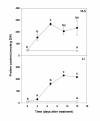Identification of drought-response genes and a study of their expression during sucrose accumulation and water deficit in sugarcane culms
- PMID: 21226964
- PMCID: PMC3030532
- DOI: 10.1186/1471-2229-11-12
Identification of drought-response genes and a study of their expression during sucrose accumulation and water deficit in sugarcane culms
Abstract
Background: The ability of sugarcane to accumulate high concentrations of sucrose in its culm requires adaptation to maintain cellular function under the high solute load. We have investigated the expression of 51 genes implicated in abiotic stress to determine their expression in the context of sucrose accumulation by studying mature and immature culm internodes of a high sucrose accumulating sugarcane cultivar. Using a sub-set of eight genes, expression was examined in mature internode tissues of sugarcane cultivars as well as ancestral and more widely related species with a range of sucrose contents. Expression of these genes was also analysed in internode tissue from a high sucrose cultivar undergoing water deficit stress to compare effects of sucrose accumulation and water deficit.
Results: A sub-set of stress-related genes that are potentially associated with sucrose accumulation in sugarcane culms was identified through correlation analysis, and these included genes encoding enzymes involved in amino acid metabolism, a sugar transporter and a transcription factor. Subsequent analysis of the expression of these stress-response genes in sugarcane plants that were under water deficit stress revealed a different transcriptional profile to that which correlated with sucrose accumulation. For example, genes with homology to late embryogenesis abundant-related proteins and dehydrin were strongly induced under water deficit but this did not correlate with sucrose content. The expression of genes encoding proline biosynthesis was associated with both sucrose accumulation and water deficit, but amino acid analysis indicated that proline was negatively correlated with sucrose concentration, and whilst total amino acid concentrations increased about seven-fold under water deficit, the relatively low concentration of proline suggested that it had no osmoprotectant role in sugarcane culms.
Conclusions: The results show that while there was a change in stress-related gene expression associated with sucrose accumulation, different mechanisms are responding to the stress induced by water deficit, because different genes had altered expression under water deficit.
Figures



References
-
- Rae AL, Grof CPL, Casu RE, Bonnett GD. Sucrose accumulation in the sugarcane stem; pathways and control points for transport and compartmentation. Field Crops Res. 2005;92:159–168. doi: 10.1016/j.fcr.2005.01.027. - DOI
-
- Arruda P, Silva TR. In: Genomics-Assisted Crop Improvement: Vol 2: Genomics Applications in Crops. Varshnet RK, Tuberosa R, editor. Dordrecht, The Netherlands, Springer; 2007. Transcriptome analysis of the sugarcane genome for crop improvement; pp. 483–494. full_text.
Publication types
MeSH terms
Substances
LinkOut - more resources
Full Text Sources

